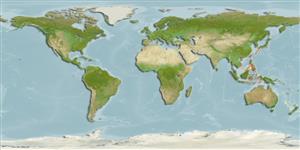Classification / Names
Noms communs | Synonymes | Catalog of Fishes(Genre, Espèce) | ITIS | CoL | WoRMS | Cloffa
Environment: milieu / climate zone / depth range / distribution range
Écologie
marin bathypélagique; profondeur 622 - 1412 m (Ref. 36330). Deep-water
Western Central Pacific: Sulu Sea.
Taille / Poids / Âge
Maturity: Lm ? range ? - ? cm
Max length : 23.4 cm SL mâle / non sexé; (Ref. 36330)
Description synthétique
Morphologie | Morphométrie
Rayons mous dorsaux (Total): 17-21; Rayons mous anaux: 14 - 18. Body shallow, maximum depth reaching 20%SL. Caudal peduncle relatively long (usually >18%SL). Vertical fin bases against each other. Head not very deep, moderately wide (postorbital width 11-12.5%SL). Snout very short but not blunt; its length 1.5-2.3 times smaller than orbit diameter; olfactory bulbs relatively large; ethymoid in olfactory bulb region relatively narrow. Eyes very large; orbit > 30% HL; no aggregations of light connective tissue in the orbit area around the eyeball; interorbital gap very narrow and < half the orbit diameter. Lacrimal not deep, significantly smaller than lens diameter, slightly overlapping maxillare. Seismosensory canals on head not extended, their pores not enlarged. No separate suprapreoperculum at the upper end of the praeoperculum; preopercular canal connects to the postorbital canal by means of a skin tube. Upper edge of upper jaw overlaps with the vertical of the rear edge of the lens, it may reach the vertical of the back edge of the orbit in large specimens. Supramaxilla 2; front one relatively long; its length equal or shorter than upper outgrowth of the posterior one. Photophores present on the head: a row of 4-5 infraorbitalias; 1 behind back edge of the orbit at its middle level; 5 on both sides along the lower jaw seismosensory canals; 2-4 along the upper 3 rays of the gill membrane; 1 each on the operculum, interoperculum, and between orbit and olfactory capsule. Photophores on body, situated above and below the lateral line, the size increases in the vertical direction that the largest ones cover the lower profile of the body; in front of the vertical fins; 3 rows in the caudal region; several irregular rows of small ones on the gill membranes. Pyloric caeca < 10 (Ref. 36330).
Life cycle and mating behavior
Maturité | Reproduction | Frai | Œufs | Fécondité | Larves
Sazonov, Y.I., 1999. A new species of the genus Rouleina (Argentiniformes, Alepocephalidae) from the Philippine Archipelago Seas and a redescription of R. livida and R. nuda. J. Ichthyol. 39(7):479-487. (Ref. 36330)
Statut dans la liste rouge de l'IUCN (Ref. 130435)
Menace pour l'homme
Harmless
Utilisations par l'homme
Plus d'informations
Noms communsSynonymesMétabolismePrédateursÉcotoxicologieReproductionMaturitéFraiRassemblement de ponteFéconditéŒufsDéveloppement de l'œuf
Taille/ÂgeCroissanceLongueur-poidsLongueur-longueurFréquences de longueursMorphométrieMorphologieLarvesDynamique des populations larvairesRecrutementAbondanceBRUVS
RéférencesAquacultureProfil d'aquacultureSouchesGénétiqueElectrophoresesHéritabilitéPathologiesTraitementNutrientsMass conversion
CollaborateursImagesStamps, Coins Misc.SonsCiguateraVitesseType de nageSurface branchialeOtolithesCerveauxVision
Outils
Articles particuliers
Télécharger en XML
Sources Internet
Estimates based on models
Preferred temperature (Ref.
123201): 5.4 - 10.1, mean 6.1 °C (based on 113 cells).
Phylogenetic diversity index (Ref.
82804): PD
50 = 0.5010 [Uniqueness, from 0.5 = low to 2.0 = high].
Bayesian length-weight: a=0.01000 (0.00244 - 0.04107), b=3.04 (2.81 - 3.27), in cm total length, based on all LWR estimates for this body shape (Ref.
93245).
Niveau trophique (Ref.
69278): 3.5 ±0.5 se; based on size and trophs of closest relatives
Résilience (Ref.
120179): Milieu, temps minimum de doublement de population : 1,4 à 4,4 années (Preliminary K or Fecundity.).
Fishing Vulnerability (Ref.
59153): Low vulnerability (19 of 100).
